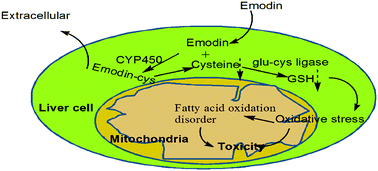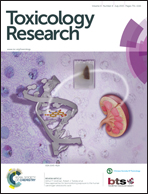Metabolomic profiling of emodin-induced cytotoxicity in human liver cells and mechanistic study†
Abstract
Emodin is one of the most representative natural anthraquinone polyphenols and the liver is one of the major target organs for drug-induced toxicology. The hepatocyte is frequently affected due to its role in emodin metabolism and accumulation. Although the hepatotoxicity of emodin has been reported, its toxicological mechanism is still unclear. The purpose of the present study was to evaluate the cytotoxicity of emodin in cultured human normal liver cells (L-02), to investigate the toxicity-related metabolic pathways and to predict the possible toxicity mechanism. Cell viability was analyzed by 3-(4,5-dimethylthiazol-2-yl)-2,5-diphenyltetrazolium bromide (MTT) assay. Cytotoxicity tests demonstrated a concentration-dependent toxic effect of emodin on L-02 cells. Cells were treated for 48 h with low, medium and high doses of emodin, respectively, and then subjected to metabolomics analysis using ultra-high performance liquid chromatography-tandem mass spectrometry (UPLC-MS). Intracellular metabolomics analysis revealed that emodin significantly disturbed cellular glutathione and fatty acid metabolism. In addition, an emodin–cysteine adduct was identified in cell culture medium, and its level increased with increasing concentrations of emodin. The possible relationship among metabolic disorders, adduct formation and emodin hepatotoxicity was also discussed. This study provides new insight into the cytotoxicity of emodin on metabolic pathways in human liver cells.


 Please wait while we load your content...
Please wait while we load your content...